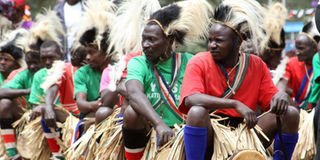Memories of joy and sorrow at Uhuru Park

Chuka drummers seat on their drums after rehearsals at Uhuru Park on August 26, 2010 ahead of Friday's promulgation of the constitution. Photo/LIZ MUTHONI
What you need to know:
Historical dates at park in the city
- Sep 1, 1978 – Kenyans gather for a prayer service after Jomo Kenyatta’s death in a two and a half hour ceremony attended by six heads of state
- Aug 19, 1985 - Pope John Paul II plants a tree at Uhuru Park after a morning mass
- Oct 1989 - Environmentalist Wangari Maathai learns of a plan to build a 60-story Kenya Times Media Trust Complex in Uhuru Park.
- Aug 9, 1998 - Thousands of Kenyans pray at the Uhuru Park for the victims of the bombing of the US embassy
- Oct 6, 2007 - Raila Odinga launches his ODM campaign
- Jan 31, 2008 - Kenyan police officers lay flowers for the victims of post-election violence
- June 13 2010 - Grenade attack on a prayer rally at Uhuru Park in Nairobi kills seven and injures 100
- May 1, 2010 - Prime Minister Raila Odinga addresses citizens during Labour Day
The green Uhuru Park rests comfortably in the heart of Nairobi ringed in by two busy highways.
The recreational venue holds poignant cultural and political memories in Kenya. It is associated with the heroes of Kenya’s independence struggle, who would assemble there to plot how to attack the enemy — the white colonialists. Uhuru is the Kiswahili equivalent of “freedom”.
Uhuru Park has since been home to history, farce, fun and muck. Freedom Corner, as christened by Nobel Prize winner Wangari Maathai, is in one corner of the Park. This is where she joined women demanding the release of their sons incarcerated by the Moi regime for political reasons.
“Some mothers whose sons were in prison came to me and asked me to help them,” Ms Maathai said in an interview with the Voice of America. “So I joined them and we decided that we would go to Uhuru Park and speak out. I gave these women the moral support to demand the release of their sons.”
Many people have planted trees at Freedom Corner. They include Illinois Senator Barrack Obama, before he became president. In 1989, Wangari Maathai held a protest to stop the construction of a 60-story business complex dreamed up by the ruling party Kanu. She succeeded in keeping the park green.
It remains the venue of choice for Kenyans to air their views on governance reforms, in addition to being a favourite venue for leisure for couples and families. This is largely due to its strategic location in the Central Business District. Adjacent to Uhuru Park is Central Park, which hosts a black memorial to the Moi era.
The park also hosts a fountain depicting the time of Kenya’s Independence. After independence in 1963, Kenya’s first president Jomo Kenyatta envisioned a park where city residents would relax in the fashion of municipal parks in western countries. But plans for the park date back to the days when the colonial government drew up a master plan for the city in 1948.
On a typical day, Kenyans will be found catching an afternoon wink under a shade here and there, a young couple enjoying a romantic picnic or parents who have brought their children to enjoy a boat ride on a metre-deep artificial lake. Archbishop Maurice Cardinal Otunga also led a group Catholics in burning a heap of condoms in Uhuru Park in August 1996.
But the park has had its fair share of dark days. In 2007 after the disputed presidential elections it was sealed off by police. Two months ago, Uhuru Park was the scene of twin grenade attacks, which killed seven people and left over 100 others injured. Residents have also reported violent attacks as they walked through the park at dusk, sometimes involving robbery and rape.
But today, the park will witness the rebirth of the nation as the new Constitution is promulgated by President Kibaki. The military will come out with tanks, armoured personnel carriers and planes during march and fly past parades. Joining Kenyans at Uhuru Park to witness the historical ceremony are Heads of States and members of the panel of Eminent Persons who helped broker the National Accord that ended the post-election violence in 2008.
Military chief General Jeremiah Kianga promised that the armed forces would today put up a show not seen in Kenya since independence in 1963.




